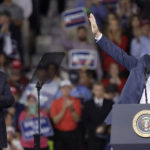
Even after Trump visit, Kansas governor’s race still tied, new poll says

photo by: Mike Yoder
President Donald Trump appears on stage with Kansas Secretary of State and gubernatorial candidate Kris Kobach at a rally Saturday, Oct. 6, 2018, at the Kansas Expocentre in Topeka.
TOPEKA — A new poll released this week suggests the Kansas governor’s race is still statistically tied, despite President Donald Trump’s high-profile campaign rally on behalf of Republican Kris Kobach earlier this month.
The survey, by the Democratic firm Public Policy Polling, shows Kobach and Democrat Laura Kelly each with 41 percent of the vote. Independent candidate Greg Orman showed up with 10 percent, and 6 percent were still undecided.
The survey of 698 Kansas voters was conducted Oct. 19-20, two weeks after Trump’s campaign rally in Topeka. It had a margin of sampling error of plus or minus 3.7 percent.
The survey was commissioned by an outside group, Western States Strategies, which has no connection to Sen. Kelly’s campaign, according to officials with the firm and the campaign.
What’s interesting, though, is that the same polling firm conducted a similar survey in September, after the first two broadcast debates between the candidates. At that time, PPP found Kobach with 39 percent, Kelly with 38 percent, and Orman at 9 percent, with 12 percent undecided.
Given the fact that both polls were conducted by the same firm, presumably using the same methodology, it suggests that little changed over the course of the month, except that undecided voters have started making their choices, and they are breaking out in roughly the same proportions as the rest of the voting population.
If that same trend holds for the final two weeks, it basically means this election will be decided by turnout — which side can get its supporters to the polls on Election Day. And if that’s the case, Trump’s campaign rally may end up having more of an impact than the polls are indicating.
Say what you will about the president, like him or not, he does have an ability to gin up his base and get them to turn out. And in a race as seemingly tight as this one, it may only take a few thousand voters here and there.
Here are a few other questions and takeaways from the PPP survey:
• Who votes: The poll was based on a sample that largely reflects typical voter turnout in Kansas. The biggest segment, 44 percent, was people between the ages of 46 and 65; 22 percent were 45 and younger; 33 percent over age 65. The party breakdown was 53 percent Republican, 32 percent Democratic and 15 percent unaffiliated.
That may not be set in stone, though. Remember the big surge of youth activism that followed the Feb. 14 mass shooting at a high school in Florida. That supposedly resulted in a big surge in voter registration among the youngest group of potential voters, those who would be 18 or a little older by Election Day.
But that was eight months ago, and it’s been a long time since anyone has seen the kind of mass demonstrations and mobilization that followed in the immediate aftermath of that tragedy. Do those young people still care what happens in this election? It remains to be seen.
• The Orman effect: There are conflicting indicators in the poll about what impact Orman is having on the race. On the one hand, he appears to be drawing more from people who would otherwise vote for Kelly than Kobach.
In a hypothetical two-person race, the poll shows Kelly leading Kobach, 48-44 percent. But with Orman, Libertarian Jeff Caldwell and independent Richard Kloos on the ballot, the top two candidates fall to a 41-41 percent tie — a net loss of seven points for Kelly, but only three for Kobach.
On the other hand, when each candidate’s supporters are broken down by party affiliation, Orman gets support from only 4 percent of people who identify as Democrats, but 10 percent of Republicans and 22 percent of unaffiliated voters in the sample.
• Cross-party pull: The PPP survey shows Kelly with more cross-party appeal than Kobach. Kelly showed up with support from 21 percent of registered Republicans, while Kobach is polling at 15 percent among Democrats. The poll also showed Kelly getting support from 11 percent of people who say they voted for Donald Trump in 2016, while Kobach gets support from only 2 percent of those who voted for Hillary Clinton.
Political scientists will caution that those numbers should be taken with a hefty grain of salt, because when survey results are broken down into subgroups, the margin of error shoots up significantly.
It is telling, though, that neither the Kansas Farm Bureau’s PAC nor the Kansas Livestock Association’s PAC made an endorsement in the governor’s race this year. Traditionally, those are two pretty reliable groups for Republicans, and a pretty accurate indicator of what’s going on in rural communities in Kansas.
KFB’s PAC endorsed Gov. Jeff Colyer in the GOP primary, and a spokesman said after that race, there was no consensus among its members about whom to support in the general election.
A spokesman for KLA’s PAC said in an interview Wednesday that they felt they could work with any of the three major candidates.







